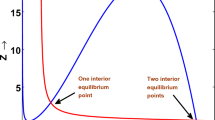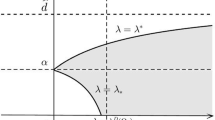Abstract
The existence of traveling waves to general predator–prey systems is an interesting and ongoing problem, and predator–prey systems that the predator spreads faster than the prey are the major focus of the previous research. In this paper, we are concerned with the existence of traveling waves to predator–prey system with the density death function of the predator when the predator is stationary. First of all, by the unstable manifold theorem, we show that pursuit and evasion waves do not exist for any wave speeds c, as well as invasion waves do not exist for any wave speeds \(c\leqslant 0\). Then, with the aid of the shooting argument, Wazewski theorem, LaSalle’s invariance principle and sophisticated analyses, we establish the existence of invasion waves for wave speed \(c>0\), which partially answers the open problem proposed in Wu (Comput. Math. Appl. 76(5):1139-1160, 2018). Finally, we apply the existence results to Yodzis predator–prey system with Holling type-III functional response and then find a new phenomenon different from previous results.




Similar content being viewed by others
Availability of data and materials
The numerical simulations in this paper are carried out using MATLAB.
References
Cantrell, R.S., Cosner, C., Ruan, S.: Spatial Ecology. CRC Press (2010)
Chen, X., Tsai, J.C.: Spreading speed in a farmers and hunter-gatherers model arising from Neolithic transition in Europe. J. Math. Pures Appl. 143, 192–207 (2020)
Dunbar, S.R.: Travelling wave solutions of diffusive Lotka-Volterra equations. J. Math. Biol. 17(1), 11–32 (1983)
Dunbar, S.R.: Traveling wave solutions of diffusive Lotka-Volterra equations: a heteroclinic connection in \({\mathbb{R}}^4\). Trans. Amer. Math. Soc., 557–594 (1984)
Dunbar, S.R.: Traveling waves in diffusive predator-prey equations: periodic orbits and point-to-periodic heteroclinic orbits. SIAM J. Appl. Math. 46(6), 1057–1078 (1986)
Du, Y., Shi, J.P.: Some recent results on diffusive predator-prey models in spatially heterogeneous environment. Nonlinear Dynam. Evol. Equ. 48, 95–135 (2006)
Ding, W., Huang, W.: Traveling wave solutions for some classes of diffusive predator-prey models. J. Dynam. Differ. Equ. 28(3), 1293–1308 (2016)
Fagan, W.F., Bishop, J.G.: Trophic interactions during primary succession: herbivores slow a plant reinvasion at Mount St. Helens. Am. Nat. 155(2), 238–251 (2000)
Hale, J.K.: Ordinary Differential Equations. Krieger Publishing Company, Robert E (1980)
Huang, J., Lu, G., Ruan, S.: Existence of traveling wave solutions in a diffusive predator-prey model. J. Math. Biol. 46(2), 132–152 (2003)
Hassell, M.P.: The Dynamics of Arthropod Predator-Prey Systems. Princeton University Press (1978)
Huang, W.: Traveling wave solutions for a class of predator-prey systems. J. Dynam. Differ. Equ. 24(3), 633–644 (2012)
Huang, W.: A geometric approach in the study of traveling waves for some classes of non-monotone reaction-diffusion systems. J. Differ. Equ. 260(3), 2190–2224 (2016)
Huang, Y., Weng, P.: Periodic traveling wave train and point-to-periodic traveling wave for a diffusive predator-prey system with Ivlev-type functional response. J. Math. Anal. Appl. 417(1), 376–393 (2014)
Hosono, Y.: Traveling waves for the Lotka-Volterra predator-prey system without diffusion of the predator. Discrete Contin. Dyn. Syst. Ser. B 20(1), 161–171 (2015)
Hsu, C.H., Yang, C.R., Yang, T.H., et al.: Existence of traveling wave solutions for diffusive predator-prey type systems. J. Differ. Equ. 252(4), 3040–3075 (2012)
Lotka, A.J.: Elements of Physical Biology. Williams & Wilkins (1925)
Leung, A.: Limiting behaviour for a prey-predator model with diffusion and crowding effects. J. Math. Biol. 6(1), 87–93 (1978)
Li, H., Xiao, H.: Traveling wave solutions for diffusive predator-prey type systems with nonlinear density dependence. Comput. Math. Appl. 74(10), 2221–2230 (2017)
Li, W.T., Wu, S.L.: Traveling waves in a diffusive predator-prey model with Holling type-III functional response. Chaos Solit. Fractals 37(2), 476–486 (2008)
Lin, X., Weng, P., Wu, C.: Traveling wave solutions for a predator-prey system with sigmoidal response function. J. Dynam. Differ. Equ. 23(4), 903–921 (2011)
Malchow, H.: Spatiotemporal Patterns in Ecology and Epidemiology: Theory, Models, and Simulation. Chapman and Hall/CRC (2007)
Murray, J.D.: Mathematical Biology. Springer-Verlag, New York (1989)
Neubert, M.G., Caswell, H.: Density-dependent vital rates and their population dynamic consequences. J. Math. Biol. 41(2), 103–121 (2000)
Owen, M.R., Lewis, M.A.: How predation can slow, stop or reverse a prey invasion. Bull. Math. Biol. 63(4), 655–684 (2001)
Pao, C.V.: Nonlinear Parabolic and Elliptic Equations. Springer Science & Business Media (2012)
Pan, S.: Invasion speed of the prey in a predator-prey system. Bull. Malays. Math. Sci. Soc. 44(6), 3983–3990 (2021)
Riechert, S.E.: S.E.: Spiders as representative ‘sit-and-wait’ predators. In: Natural Enemies: The Population Biology of Predators, Parasites and Diseases, 313–328 (1992)
Safuan, H.M., Towers, I.N., Jovanoski, Z., et al.: On travelling wave solutions of the diffusive Leslie-Gower model. Appl. Math. Comput. 274, 362–371 (2016)
Volterra, V.: Fluctuations in the abundance of a species considered mathematically. Nature 118(2972), 558–560 (1926)
Wu, Y., Xiao, H.: Traveling wave solutions for Gause type predator-prey systems with density dependence: a heteroclinic orbit in \({\mathbb{R} }^4\). Comput. Math. Appl. 76(5), 1139–1160 (2018)
Yang, D., Liu, M.: Traveling wave solutions in a diffusive predator-prey system with Holling type-III functional response. Jpn. J. Ind. Appl. Math. 39(1), 97–118 (2022)
Zhang, Z., Yang, T.H., Wang, W.: Traveling wave solutions of Lotka-Volterra type two predators one prey model. Math. Methods Appl. Sci. 39(18), 5395–5408 (2016)
Acknowledgements
The authors are grateful to the anonymous referees for their useful suggestions which improve the contents of this paper.
Funding
Yang Wang’s research is supported in part by the National Natural Science Foundation of China (No.11901366) and Shanxi Scholarship Council of China (2021-001). Rong Yuan’s research is supported in part by the National Natural Science Foundation of China (No.12171039 and 12271044). Zhaohai Ma’s research is supported in part by the National Natural Science Foundation of China (No.12001502).
Author information
Authors and Affiliations
Contributions
Hongliang Li wrote the main manuscript text. All authors reviewed the manuscript.
Corresponding author
Ethics declarations
Conflict of interest
The authors declare that they have no conflict of interest.
Ethics approval and consent to participate
This research did not involve human participants or animals.
Consent for publication
Not applicable.
Additional information
Publisher's Note
Springer Nature remains neutral with regard to jurisdictional claims in published maps and institutional affiliations.
Rights and permissions
Springer Nature or its licensor (e.g. a society or other partner) holds exclusive rights to this article under a publishing agreement with the author(s) or other rightsholder(s); author self-archiving of the accepted manuscript version of this article is solely governed by the terms of such publishing agreement and applicable law.
About this article
Cite this article
Li, H., Wang, Y., Yuan, R. et al. Traveling waves of predator–prey system with a sedentary predator. Z. Angew. Math. Phys. 74, 198 (2023). https://doi.org/10.1007/s00033-023-02092-9
Received:
Revised:
Accepted:
Published:
DOI: https://doi.org/10.1007/s00033-023-02092-9
Keywords
- Predator–prey systems
- Pursuit and evasion waves
- Invasion waves
- Wazewski theorem
- LaSalle’s invariance principle




